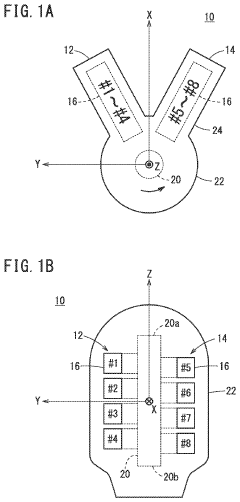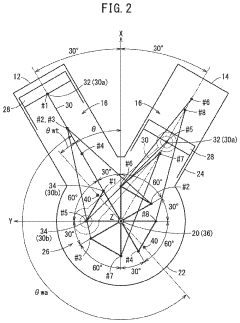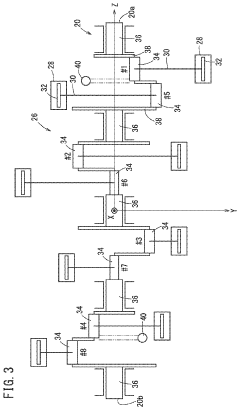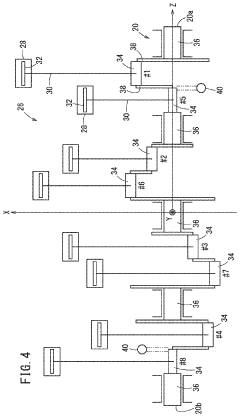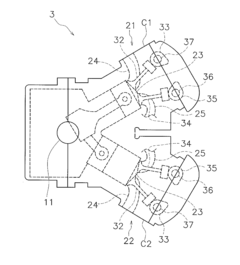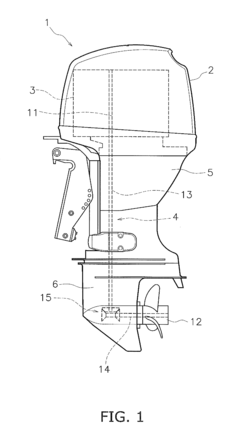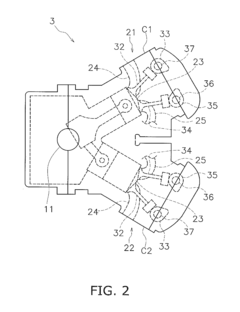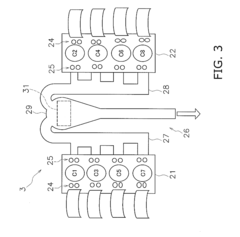How V8 Engines Drive Technological Advancements?
JUL 4, 20259 MIN READ
Generate Your Research Report Instantly with AI Agent
Patsnap Eureka helps you evaluate technical feasibility & market potential.
V8 Engine Evolution
The V8 engine has undergone significant evolution since its inception in the early 20th century. This powerful internal combustion engine design has been a driving force behind technological advancements in the automotive industry and beyond. The timeline of V8 engine development showcases a series of innovations that have continuously improved performance, efficiency, and reliability.
In the 1900s, the first V8 engines emerged, primarily used in racing cars and luxury vehicles. These early designs laid the foundation for future developments, featuring a compact layout that allowed for increased power output in a relatively small package. The 1920s and 1930s saw the popularization of V8 engines in mass-produced vehicles, with notable examples like the Ford Flathead V8 introduced in 1932.
The post-World War II era marked a significant leap in V8 technology. The 1950s and 1960s witnessed the rise of high-performance V8 engines, particularly in American muscle cars. This period saw advancements in valve train designs, increased compression ratios, and the introduction of overhead valve (OHV) configurations, all contributing to substantial gains in horsepower and torque.
The 1970s brought new challenges with the oil crisis and stricter emissions regulations. This prompted engineers to focus on improving fuel efficiency and reducing emissions without sacrificing performance. Electronic fuel injection systems began replacing carburetors, marking the start of a new era in engine management and control.
The 1980s and 1990s saw further refinements in V8 technology. Computer-controlled engine management systems became more sophisticated, allowing for precise control over fuel delivery and ignition timing. Variable valve timing (VVT) technology was introduced, improving both performance and efficiency across a wider range of operating conditions.
In the 21st century, V8 engines have continued to evolve, incorporating advanced materials and manufacturing techniques. Aluminum block and head construction have become commonplace, reducing weight and improving heat dissipation. Direct fuel injection, turbocharging, and cylinder deactivation technologies have been widely adopted, significantly enhancing fuel economy without compromising power output.
Recent years have seen a focus on hybridization and electrification, with V8 engines being integrated into hybrid powertrains to meet increasingly stringent emissions standards while maintaining high performance levels. Additionally, advancements in 3D printing and computational fluid dynamics have allowed for more complex and efficient designs, pushing the boundaries of what's possible with V8 engine technology.
In the 1900s, the first V8 engines emerged, primarily used in racing cars and luxury vehicles. These early designs laid the foundation for future developments, featuring a compact layout that allowed for increased power output in a relatively small package. The 1920s and 1930s saw the popularization of V8 engines in mass-produced vehicles, with notable examples like the Ford Flathead V8 introduced in 1932.
The post-World War II era marked a significant leap in V8 technology. The 1950s and 1960s witnessed the rise of high-performance V8 engines, particularly in American muscle cars. This period saw advancements in valve train designs, increased compression ratios, and the introduction of overhead valve (OHV) configurations, all contributing to substantial gains in horsepower and torque.
The 1970s brought new challenges with the oil crisis and stricter emissions regulations. This prompted engineers to focus on improving fuel efficiency and reducing emissions without sacrificing performance. Electronic fuel injection systems began replacing carburetors, marking the start of a new era in engine management and control.
The 1980s and 1990s saw further refinements in V8 technology. Computer-controlled engine management systems became more sophisticated, allowing for precise control over fuel delivery and ignition timing. Variable valve timing (VVT) technology was introduced, improving both performance and efficiency across a wider range of operating conditions.
In the 21st century, V8 engines have continued to evolve, incorporating advanced materials and manufacturing techniques. Aluminum block and head construction have become commonplace, reducing weight and improving heat dissipation. Direct fuel injection, turbocharging, and cylinder deactivation technologies have been widely adopted, significantly enhancing fuel economy without compromising power output.
Recent years have seen a focus on hybridization and electrification, with V8 engines being integrated into hybrid powertrains to meet increasingly stringent emissions standards while maintaining high performance levels. Additionally, advancements in 3D printing and computational fluid dynamics have allowed for more complex and efficient designs, pushing the boundaries of what's possible with V8 engine technology.
Market Demand Analysis
The market demand for V8 engines has been evolving rapidly, driven by a combination of technological advancements, changing consumer preferences, and regulatory pressures. In the automotive sector, V8 engines have long been associated with high-performance vehicles, luxury cars, and powerful trucks. However, the market landscape is shifting as manufacturers and consumers alike seek more fuel-efficient and environmentally friendly options.
Despite the growing emphasis on electric and hybrid vehicles, there remains a significant demand for V8 engines in specific market segments. The sports car and luxury vehicle markets continue to value the power, performance, and prestige associated with V8 engines. Additionally, the heavy-duty truck and commercial vehicle sectors rely on V8 engines for their torque and towing capabilities.
The global V8 engine market has shown resilience, with steady growth projected in certain regions. North America, in particular, maintains a strong demand for V8-powered vehicles, especially in the pickup truck segment. The Middle East and parts of Asia also demonstrate a continued appetite for high-performance luxury vehicles equipped with V8 engines.
However, the market is not without challenges. Stringent emissions regulations and fuel economy standards are pushing manufacturers to innovate and improve V8 engine efficiency. This has led to the development of advanced technologies such as cylinder deactivation, direct injection, and turbocharging, which aim to enhance fuel economy without sacrificing performance.
The racing and motorsport industry continues to be a significant driver of V8 engine demand and technological advancement. Formula 1, NASCAR, and other racing series provide a platform for pushing the boundaries of V8 engine performance and efficiency, with innovations often trickling down to consumer vehicles.
In the marine sector, V8 engines maintain a strong presence in high-performance boats and luxury yachts. The demand for powerful, reliable engines in marine applications ensures a steady market for V8 technology in this niche.
Looking ahead, the market for V8 engines is expected to undergo further transformation. While some segments may see a decline due to the shift towards electrification, others are likely to benefit from ongoing technological improvements. The integration of hybrid systems with V8 engines is emerging as a potential growth area, offering a compromise between performance and efficiency.
As manufacturers continue to invest in research and development, the V8 engine market is poised for innovation-driven growth. The focus on reducing emissions, improving fuel efficiency, and enhancing overall performance will shape the future demand for V8 engines across various industries.
Despite the growing emphasis on electric and hybrid vehicles, there remains a significant demand for V8 engines in specific market segments. The sports car and luxury vehicle markets continue to value the power, performance, and prestige associated with V8 engines. Additionally, the heavy-duty truck and commercial vehicle sectors rely on V8 engines for their torque and towing capabilities.
The global V8 engine market has shown resilience, with steady growth projected in certain regions. North America, in particular, maintains a strong demand for V8-powered vehicles, especially in the pickup truck segment. The Middle East and parts of Asia also demonstrate a continued appetite for high-performance luxury vehicles equipped with V8 engines.
However, the market is not without challenges. Stringent emissions regulations and fuel economy standards are pushing manufacturers to innovate and improve V8 engine efficiency. This has led to the development of advanced technologies such as cylinder deactivation, direct injection, and turbocharging, which aim to enhance fuel economy without sacrificing performance.
The racing and motorsport industry continues to be a significant driver of V8 engine demand and technological advancement. Formula 1, NASCAR, and other racing series provide a platform for pushing the boundaries of V8 engine performance and efficiency, with innovations often trickling down to consumer vehicles.
In the marine sector, V8 engines maintain a strong presence in high-performance boats and luxury yachts. The demand for powerful, reliable engines in marine applications ensures a steady market for V8 technology in this niche.
Looking ahead, the market for V8 engines is expected to undergo further transformation. While some segments may see a decline due to the shift towards electrification, others are likely to benefit from ongoing technological improvements. The integration of hybrid systems with V8 engines is emerging as a potential growth area, offering a compromise between performance and efficiency.
As manufacturers continue to invest in research and development, the V8 engine market is poised for innovation-driven growth. The focus on reducing emissions, improving fuel efficiency, and enhancing overall performance will shape the future demand for V8 engines across various industries.
Technical Challenges
V8 engines, despite their long history and widespread use, continue to face significant technical challenges in the pursuit of technological advancements. One of the primary obstacles is the ongoing struggle to improve fuel efficiency while maintaining or enhancing performance. As environmental concerns grow and regulations tighten, engine designers must find innovative ways to reduce fuel consumption and emissions without compromising power output.
Another major challenge lies in the realm of materials science. The quest for lighter, stronger, and more heat-resistant materials is crucial for improving engine efficiency and durability. Traditional materials often struggle to withstand the extreme temperatures and pressures within modern high-performance V8 engines, necessitating the development of advanced alloys and composites.
The integration of advanced electronic control systems presents yet another hurdle. While these systems offer unprecedented precision in engine management, they also introduce complexity and potential points of failure. Engineers must balance the benefits of sophisticated control algorithms with the need for reliability and ease of maintenance.
Thermal management remains a persistent challenge in V8 engine design. As power outputs increase, so does the heat generated, requiring more efficient cooling systems. This challenge is compounded in high-performance and racing applications, where weight and space constraints limit traditional cooling solutions.
The push towards electrification and hybrid powertrains introduces new complexities for V8 engine development. Integrating electric motors and battery systems with traditional V8 architectures requires careful consideration of packaging, weight distribution, and power delivery characteristics.
Noise, vibration, and harshness (NVH) control continues to be a significant technical challenge, particularly as consumer expectations for comfort rise. Engineers must find ways to dampen the inherent vibrations of the V8 configuration without adding excessive weight or compromising the engine's characteristic sound.
Lastly, the challenge of scalability and manufacturing efficiency looms large. As V8 engines become more technologically advanced, production processes must evolve to maintain cost-effectiveness and quality control. This includes developing new manufacturing techniques and implementing advanced quality assurance measures.
These technical challenges collectively drive innovation in V8 engine technology, pushing the boundaries of what is possible in internal combustion engine design. Overcoming these hurdles requires interdisciplinary collaboration and a continuous commitment to research and development, ensuring that V8 engines remain at the forefront of automotive technology.
Another major challenge lies in the realm of materials science. The quest for lighter, stronger, and more heat-resistant materials is crucial for improving engine efficiency and durability. Traditional materials often struggle to withstand the extreme temperatures and pressures within modern high-performance V8 engines, necessitating the development of advanced alloys and composites.
The integration of advanced electronic control systems presents yet another hurdle. While these systems offer unprecedented precision in engine management, they also introduce complexity and potential points of failure. Engineers must balance the benefits of sophisticated control algorithms with the need for reliability and ease of maintenance.
Thermal management remains a persistent challenge in V8 engine design. As power outputs increase, so does the heat generated, requiring more efficient cooling systems. This challenge is compounded in high-performance and racing applications, where weight and space constraints limit traditional cooling solutions.
The push towards electrification and hybrid powertrains introduces new complexities for V8 engine development. Integrating electric motors and battery systems with traditional V8 architectures requires careful consideration of packaging, weight distribution, and power delivery characteristics.
Noise, vibration, and harshness (NVH) control continues to be a significant technical challenge, particularly as consumer expectations for comfort rise. Engineers must find ways to dampen the inherent vibrations of the V8 configuration without adding excessive weight or compromising the engine's characteristic sound.
Lastly, the challenge of scalability and manufacturing efficiency looms large. As V8 engines become more technologically advanced, production processes must evolve to maintain cost-effectiveness and quality control. This includes developing new manufacturing techniques and implementing advanced quality assurance measures.
These technical challenges collectively drive innovation in V8 engine technology, pushing the boundaries of what is possible in internal combustion engine design. Overcoming these hurdles requires interdisciplinary collaboration and a continuous commitment to research and development, ensuring that V8 engines remain at the forefront of automotive technology.
Current V8 Solutions
01 V8 Engine Design and Configuration
V8 engines are designed with eight cylinders arranged in two banks of four, forming a V-shape. This configuration allows for a compact design, improved balance, and higher power output compared to inline engines. Various aspects of V8 engine design, including cylinder arrangement, crankshaft configuration, and valve train systems, are continuously optimized for better performance and efficiency.- V8 Engine Design and Configuration: V8 engines are designed with eight cylinders arranged in two banks of four, forming a V-shape. This configuration allows for compact packaging, improved balance, and higher power output compared to inline engines. Various design aspects, such as cylinder firing order, crankshaft design, and valve arrangement, are optimized for performance and efficiency.
- Fuel Injection and Combustion Systems: Advanced fuel injection and combustion systems are implemented in V8 engines to enhance performance and reduce emissions. These may include direct injection, variable valve timing, and cylinder deactivation technologies. Optimizing fuel delivery and combustion processes improves engine efficiency and power output while meeting stringent emission standards.
- Turbocharging and Supercharging: Forced induction systems, such as turbochargers and superchargers, are often employed in V8 engines to increase power output and efficiency. These systems compress the intake air, allowing more fuel to be burned and generating higher power from a smaller displacement engine. Various designs and configurations of forced induction systems are used to optimize performance across different operating conditions.
- Engine Block and Component Materials: Advanced materials and manufacturing techniques are used in V8 engine construction to reduce weight, improve durability, and enhance heat dissipation. This may include the use of aluminum alloys, composite materials, or specialized coatings for engine blocks, cylinder heads, and other critical components. Material selection and design optimization contribute to improved performance and longevity of V8 engines.
- Cooling and Lubrication Systems: Efficient cooling and lubrication systems are crucial for V8 engine performance and longevity. Advanced cooling strategies, such as precision cooling and variable flow systems, help maintain optimal operating temperatures. Sophisticated lubrication systems ensure proper oil distribution to all critical components, reducing friction and wear. These systems are designed to handle the high heat and stress generated by high-performance V8 engines.
02 Fuel Injection and Combustion Systems
Advanced fuel injection and combustion systems are crucial for V8 engine performance and efficiency. These systems include direct injection, variable valve timing, and cylinder deactivation technologies. Innovations in this area focus on improving fuel atomization, optimizing air-fuel mixture, and enhancing combustion efficiency to increase power output while reducing fuel consumption and emissions.Expand Specific Solutions03 Turbocharging and Supercharging
Forced induction systems, such as turbochargers and superchargers, are frequently used in V8 engines to boost power output and efficiency. These systems compress the intake air, allowing more fuel to be burned and increasing engine power. Recent developments focus on reducing turbo lag, improving boost control, and integrating electric compressors for enhanced performance across the entire RPM range.Expand Specific Solutions04 Engine Management and Control Systems
Sophisticated engine management and control systems are essential for optimizing V8 engine performance, fuel efficiency, and emissions. These systems incorporate advanced sensors, actuators, and electronic control units to monitor and adjust various engine parameters in real-time. Innovations in this area include adaptive engine mapping, predictive control algorithms, and integration with vehicle dynamics systems for improved overall performance.Expand Specific Solutions05 Materials and Manufacturing Techniques
Advancements in materials science and manufacturing techniques play a crucial role in V8 engine development. Lightweight materials such as aluminum alloys, composites, and high-strength steels are used to reduce engine weight and improve power-to-weight ratios. Novel manufacturing processes, including 3D printing and advanced casting techniques, enable the production of complex engine components with improved performance characteristics and reduced production costs.Expand Specific Solutions
Key Industry Players
The V8 engine technology market is in a mature stage, with a substantial global market size driven by automotive and industrial applications. Major players like GM, Toyota, BMW, Honda, and Ford have established strong positions, leveraging decades of R&D experience. The technology's maturity is evident in its widespread adoption, but ongoing innovations focus on improving efficiency, reducing emissions, and integrating with hybrid systems. Emerging players such as Great Wall Motor and BorgWarner are also making significant contributions, particularly in areas like electrification and performance enhancement, indicating a competitive and evolving landscape in V8 engine technology.
GM Global Technology Operations LLC
Technical Solution: GM has been at the forefront of V8 engine innovation, particularly with their Small Block V8 series. Their latest V8 engines incorporate advanced technologies such as Dynamic Fuel Management (DFM) and Active Fuel Management (AFM) systems, which can deactivate cylinders for improved fuel efficiency[1]. GM's V8 engines also feature direct injection, variable valve timing, and advanced materials like aluminum blocks for weight reduction. The company has developed a new 6.2L V8 engine with a flat-plane crankshaft design, delivering high-performance output while meeting stringent emissions standards[2]. GM's V8 engines are continuously evolving to balance power, efficiency, and environmental considerations, with some models achieving up to 15% improvement in fuel economy compared to previous generations[3].
Strengths: Long history of V8 development, advanced fuel management systems, high-performance capabilities. Weaknesses: Increasing pressure to shift towards electrification may limit future V8 development resources.
Toyota Motor Corp.
Technical Solution: Toyota's approach to V8 engine technology focuses on reliability and efficiency. Their UR series V8 engines, used in various models including the Lexus line, incorporate dual overhead camshafts, variable valve timing with intelligence (VVT-i), and direct fuel injection[4]. Toyota has also developed a high-output V8 for their performance vehicles, such as the 5.0L engine in the Lexus RC F, which utilizes both port and direct injection for optimal fuel delivery across all RPM ranges[5]. In recent years, Toyota has been working on improving the thermal efficiency of their V8 engines, with some versions achieving over 40% thermal efficiency, significantly higher than the average internal combustion engine[6]. This focus on efficiency helps Toyota balance the power demands of V8 engines with increasingly stringent environmental regulations.
Strengths: High reliability, focus on efficiency improvements, advanced thermal management. Weaknesses: Less emphasis on high-performance V8s compared to some competitors.
Core V8 Innovations
V8 engine
PatentActiveUS11821359B2
Innovation
- The V8 engine configuration features crank pins arranged at 90° intervals on one bank and offset by 60° on the other bank, allowing for cancellation of primary inertia couples without additional specialized parts by optimizing the arrangement of crank pins and connecting rods.
V8 engine and outboard motor
PatentActiveUS20160341097A1
Innovation
- A V8 engine design with a simple construction featuring aggregated exhaust pathways and adjustable exhaust cams, where the central angle of exhaust cams for each cylinder is optimized to minimize valve overlap and reduce exhaust interference, allowing for even firing intervals and improved exhaust gas management.
Environmental Impact
V8 engines, while renowned for their power and performance, have long been associated with significant environmental concerns. The impact of these engines on the environment is multifaceted, encompassing issues related to emissions, fuel consumption, and resource utilization. As technological advancements continue to shape the automotive industry, there is an increasing focus on mitigating the environmental footprint of V8 engines.
One of the primary environmental challenges posed by V8 engines is their high carbon dioxide emissions. These engines typically consume more fuel than their smaller counterparts, resulting in increased greenhouse gas emissions. This has led to stricter emissions regulations worldwide, pushing manufacturers to develop innovative solutions to reduce the environmental impact of V8 engines.
In response to these challenges, engine manufacturers have implemented various technologies to improve fuel efficiency and reduce emissions. Variable valve timing, cylinder deactivation, and direct fuel injection are among the advancements that have significantly enhanced the environmental performance of V8 engines. These technologies allow for more precise control over fuel consumption and combustion processes, leading to reduced emissions and improved overall efficiency.
The development of hybrid V8 systems represents another significant step towards environmental sustainability. By combining electric motors with traditional V8 engines, manufacturers have created powertrains that offer the performance characteristics of a V8 while substantially reducing fuel consumption and emissions. This hybrid approach allows for electric-only operation in urban environments, further minimizing the environmental impact in densely populated areas.
Material science advancements have also played a crucial role in improving the environmental profile of V8 engines. The use of lightweight materials, such as aluminum and carbon fiber, in engine construction has led to reduced vehicle weight, thereby improving fuel efficiency and reducing emissions. Additionally, advancements in catalytic converter technology have significantly reduced harmful exhaust emissions, including nitrogen oxides and particulate matter.
Despite these improvements, the environmental impact of V8 engines remains a concern. The production and disposal of these engines involve resource-intensive processes that contribute to their overall environmental footprint. As such, there is ongoing research into sustainable manufacturing practices and end-of-life recycling strategies for V8 engines and their components.
Looking ahead, the future of V8 engines in the context of environmental sustainability remains uncertain. While technological advancements continue to improve their efficiency and reduce emissions, the automotive industry's shift towards electrification poses significant challenges to the long-term viability of V8 engines. However, the ongoing development of synthetic fuels and hydrogen combustion technologies may offer new pathways for V8 engines to remain relevant in an increasingly environmentally conscious automotive landscape.
One of the primary environmental challenges posed by V8 engines is their high carbon dioxide emissions. These engines typically consume more fuel than their smaller counterparts, resulting in increased greenhouse gas emissions. This has led to stricter emissions regulations worldwide, pushing manufacturers to develop innovative solutions to reduce the environmental impact of V8 engines.
In response to these challenges, engine manufacturers have implemented various technologies to improve fuel efficiency and reduce emissions. Variable valve timing, cylinder deactivation, and direct fuel injection are among the advancements that have significantly enhanced the environmental performance of V8 engines. These technologies allow for more precise control over fuel consumption and combustion processes, leading to reduced emissions and improved overall efficiency.
The development of hybrid V8 systems represents another significant step towards environmental sustainability. By combining electric motors with traditional V8 engines, manufacturers have created powertrains that offer the performance characteristics of a V8 while substantially reducing fuel consumption and emissions. This hybrid approach allows for electric-only operation in urban environments, further minimizing the environmental impact in densely populated areas.
Material science advancements have also played a crucial role in improving the environmental profile of V8 engines. The use of lightweight materials, such as aluminum and carbon fiber, in engine construction has led to reduced vehicle weight, thereby improving fuel efficiency and reducing emissions. Additionally, advancements in catalytic converter technology have significantly reduced harmful exhaust emissions, including nitrogen oxides and particulate matter.
Despite these improvements, the environmental impact of V8 engines remains a concern. The production and disposal of these engines involve resource-intensive processes that contribute to their overall environmental footprint. As such, there is ongoing research into sustainable manufacturing practices and end-of-life recycling strategies for V8 engines and their components.
Looking ahead, the future of V8 engines in the context of environmental sustainability remains uncertain. While technological advancements continue to improve their efficiency and reduce emissions, the automotive industry's shift towards electrification poses significant challenges to the long-term viability of V8 engines. However, the ongoing development of synthetic fuels and hydrogen combustion technologies may offer new pathways for V8 engines to remain relevant in an increasingly environmentally conscious automotive landscape.
Performance Benchmarks
Performance benchmarks play a crucial role in evaluating the technological advancements driven by V8 engines. These benchmarks provide quantitative measures of engine performance, allowing engineers and researchers to assess improvements and compare different engine designs objectively.
One of the primary performance metrics for V8 engines is horsepower output. Modern V8 engines have shown significant increases in horsepower over the years, with some high-performance models exceeding 700 horsepower. This dramatic improvement is attributed to advancements in engine design, materials, and fuel injection technologies.
Torque is another essential benchmark for V8 engines. The ability to produce high torque at lower RPMs has been a focus of recent developments, resulting in engines that offer improved acceleration and towing capabilities. Many contemporary V8 engines can generate peak torque at around 2,000 to 3,000 RPM, enhancing overall vehicle performance.
Fuel efficiency has become an increasingly important benchmark for V8 engines. Despite their reputation for high fuel consumption, modern V8 engines have made substantial progress in this area. Technologies such as direct injection, variable valve timing, and cylinder deactivation have contributed to improved fuel economy without sacrificing power output.
Emissions performance is a critical benchmark, especially given stringent environmental regulations. V8 engine manufacturers have invested heavily in technologies to reduce harmful emissions, including advanced catalytic converters, exhaust gas recirculation systems, and particulate filters. These advancements have allowed V8 engines to meet increasingly strict emissions standards while maintaining their performance characteristics.
Durability and longevity are also key benchmarks for V8 engines. Improvements in materials science and manufacturing processes have led to engines that can withstand higher temperatures and pressures, resulting in increased reliability and longer service life. Many modern V8 engines are designed to operate for hundreds of thousands of miles with proper maintenance.
Noise, vibration, and harshness (NVH) characteristics are important benchmarks that reflect the refinement of V8 engines. Advancements in engine mounting systems, sound insulation, and precision manufacturing have resulted in smoother, quieter V8 engines that provide a more comfortable driving experience without compromising the distinctive V8 sound that enthusiasts appreciate.
These performance benchmarks collectively demonstrate how V8 engines continue to drive technological advancements in the automotive industry. By pushing the boundaries of power, efficiency, and refinement, V8 engines remain at the forefront of engine technology, inspiring innovations that often trickle down to other engine configurations and contribute to the overall progress of automotive engineering.
One of the primary performance metrics for V8 engines is horsepower output. Modern V8 engines have shown significant increases in horsepower over the years, with some high-performance models exceeding 700 horsepower. This dramatic improvement is attributed to advancements in engine design, materials, and fuel injection technologies.
Torque is another essential benchmark for V8 engines. The ability to produce high torque at lower RPMs has been a focus of recent developments, resulting in engines that offer improved acceleration and towing capabilities. Many contemporary V8 engines can generate peak torque at around 2,000 to 3,000 RPM, enhancing overall vehicle performance.
Fuel efficiency has become an increasingly important benchmark for V8 engines. Despite their reputation for high fuel consumption, modern V8 engines have made substantial progress in this area. Technologies such as direct injection, variable valve timing, and cylinder deactivation have contributed to improved fuel economy without sacrificing power output.
Emissions performance is a critical benchmark, especially given stringent environmental regulations. V8 engine manufacturers have invested heavily in technologies to reduce harmful emissions, including advanced catalytic converters, exhaust gas recirculation systems, and particulate filters. These advancements have allowed V8 engines to meet increasingly strict emissions standards while maintaining their performance characteristics.
Durability and longevity are also key benchmarks for V8 engines. Improvements in materials science and manufacturing processes have led to engines that can withstand higher temperatures and pressures, resulting in increased reliability and longer service life. Many modern V8 engines are designed to operate for hundreds of thousands of miles with proper maintenance.
Noise, vibration, and harshness (NVH) characteristics are important benchmarks that reflect the refinement of V8 engines. Advancements in engine mounting systems, sound insulation, and precision manufacturing have resulted in smoother, quieter V8 engines that provide a more comfortable driving experience without compromising the distinctive V8 sound that enthusiasts appreciate.
These performance benchmarks collectively demonstrate how V8 engines continue to drive technological advancements in the automotive industry. By pushing the boundaries of power, efficiency, and refinement, V8 engines remain at the forefront of engine technology, inspiring innovations that often trickle down to other engine configurations and contribute to the overall progress of automotive engineering.
Unlock deeper insights with Patsnap Eureka Quick Research — get a full tech report to explore trends and direct your research. Try now!
Generate Your Research Report Instantly with AI Agent
Supercharge your innovation with Patsnap Eureka AI Agent Platform!
